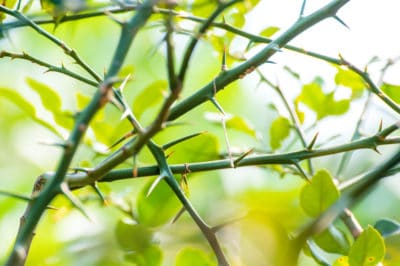Why Lime Trees Have Thorns
Lime trees developed thorns as a way to discourage hungry animals from nibbling on their tender young leaves:
- In the case of Kaffir limes, strong spines up to 1 ½ inches long protrude from the branches just beneath each cluster of lemon-scented leaves.
- The thorns on small, shrubby Key limes are just as sharp. But they’re also much more numerous, and — at only 3/8-inches long — much harder to spot.
Thorns on Budded Lime Trees
Growers often propagate lime trees by budding them on to more cold-hardy citrus variety. They fuse a single vegetative lime tree bud, or scion, onto the roots, or stock, of another tree.
The trifoliate orange (Citrus trifoliata) hardy to USDA zone 6 is often used as rootstock. It boasts abundant, 1- to 2-inch thorns. Limes budded on to trifoliate oranges often sprout thorns.
Thorny Suckers on Budded Lime Trees
Thorny suckers often grow from the bases of budded limes. Trifoliate orange suckers will eventually form a very thorny thicket. Suckers also steal nutrients, so remove them immediately.
Wait for the Trees to Outgrow Their Thorns
Budded lime trees are most likely to grow thorns while still young. Why? Because their leaves are delicate enough to tempt hungry wildlife.
In most instances the thorns disappear as the trees mature. Key and Kaffir limes are another story.
Harvesting Thorny Lime Trees
When harvesting thorny Key or Kaffir limes, wearing a pair of heavy-duty, forearm-length leather gloves is essential. Just hold a branch in one hand, grasp a lime or stem of Kaffir leaves in the other and twist it free.
Expert gardener’s tip: For thorn-free harvesting, just wait for the Key limes to turn yellow and fall to the ground, When collected at this, they’re completely ripe, so use or juice them right away.
Thornless Persian Lime Trees
If you live in USDA zone 10 or 11, grow a Persian lime tree (Citrus latifolia) and forget about thorns, because it won’t have any. What it will have are large, seedless, tangy limes that ripen all year long.
